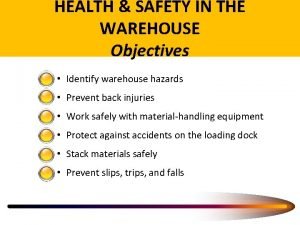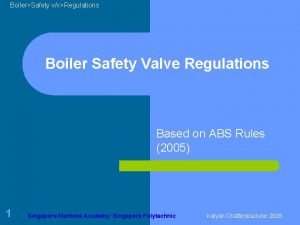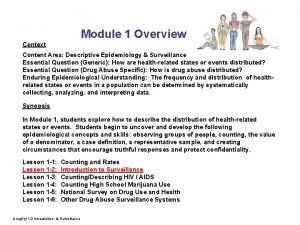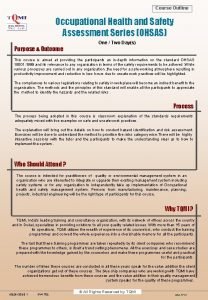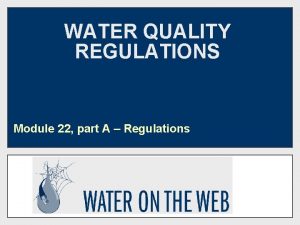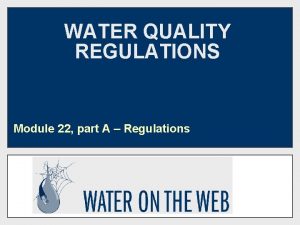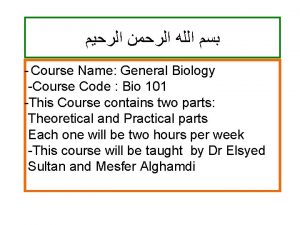Course 101 Overview General Safety and Regulations Module








![Knowledge Check [Image] Item 1 Item 2 Which items, if any, are shown in Knowledge Check [Image] Item 1 Item 2 Which items, if any, are shown in](https://slidetodoc.com/presentation_image_h2/e21e03803cc1d266152bd282016ce987/image-9.jpg)





![Learning Application [Video] Question 1 Text Item 1 Item 3 Item 4 Task 1 Learning Application [Video] Question 1 Text Item 1 Item 3 Item 4 Task 1](https://slidetodoc.com/presentation_image_h2/e21e03803cc1d266152bd282016ce987/image-15.jpg)

- Slides: 16

Course 101: Overview, General Safety and Regulations Module 4 Tools of the Trade of Traction Power Systems Slide 1

Review Slide: Module 3 Overview Regulatory Authority Regulatory Agencies Publications What is it? Federal NFPA (NEC) 70 Local EIFESH ANSI Essential Requirements Slide 2

Module 4 Learning Objectives Identify the function and use of a DC Voltmeter Identify the functions and use of a Digital Voltmeter Identify the functions and use of a hot stick Identify the functions and use of grounding cables Identify the functions and use of Hi-Pot testing and a digital low resistance ohmmeter Slide 3

Section One: Overview Slide 4

Section Two: Common Traction Power Tools Slide 5

DC Voltmeter A DC Voltmeter is a measuring device that allows one to measure the direct current (DC) voltage of a system at two points of a circuit once DC voltage is applied. Please note that this must be a company-approved model that will suit the needs of your agency. A DC voltmeter is placed into the circuit in a formation parallel with the two points of connection, though in parallel the two points experience the same potential voltage difference. In [FIGURE left] circuit illustration, the DC voltmeter is represented by the letter “V”. The two black circles in the circuit are the connection points for the DC Voltmeter. The DC voltmeter has either an analog or digital readout indicating voltage. Slide 6

Digital Voltmeter(DVM) The Digital Voltmeter can also take measurements such as voltage, current and resistance. Comes with extra accessories that can be equipped for various scenarios that require a different measurement such as measuring voltage, amperage or resistance of a series. A DVM is similar to a DC Voltmeter in that it is also plugged parallel into a series to take different measurements and a variety of basic functions for measuring current (amps), voltage (V) and resistance (Ω). Refer to local agency policy or OEM guides on how to use your multimeter. There are four major areas to remember when using a digital voltmeter: Display, Buttons, Dial (rotary switch) and Input Jacks. Slide 7

Video Text Box Slide 8
![Knowledge Check Image Item 1 Item 2 Which items if any are shown in Knowledge Check [Image] Item 1 Item 2 Which items, if any, are shown in](https://slidetodoc.com/presentation_image_h2/e21e03803cc1d266152bd282016ce987/image-9.jpg)
Knowledge Check [Image] Item 1 Item 2 Which items, if any, are shown in the picture that are arc flash hazards? Item 3 Item 4 Slide 9

Hot Stick an insulated device (usually fiberglass) that acts as an extendible tool for anyone working in highenergized areas or systems to protect them against electric shocks, burns and other serious injuries provides insulation but also physical distance between a worker and the source of electric current. Any hot stick being used will require periodic testing and re-certification to make sure they are safe to use, while also being kept clean (primarily of grease) and maintained Slide 10#

Grounding cables (wires) Grounding cables are a type of cable that are used to ground the electric current being supplied to the overhead system. Grounding cables allow for an alternate path for the current to flow through without subjecting a maintainer to potential shock and burn hazards. Agencies often use a grounding stick [FIGURE] to help adjust and affix the cables to the cable system. A lot of agencies use a different style ground cable that can be used by switching out the head of the hot stick. Add magnetic grounds that would attach to street level systems Slide 11#

HI-pot testing Also known as dielectric strength testing, hi-pot testing is a technique for testing for high potential—or high voltage— and checks for “good” insulation levels that ensure no current flows from one point to the next. Hi-Pot testing helps a worker look for any problems such as: • Leakage areas and or gaps for possible current flow • Nicks and crushed insulation and stray wires • Conductor/corrosive contaminants, shielding issues • Terminal spacing issues • Tolerance errors Slide 12

Digital Low Resistance Ohmmeter (DLRO) A digital low resistance ohmmeter—or DLRO testing —can be used to examine for lack of current flow through a switch or set of contacts. This is a crucial task as one needs to identify lack of resistance in devices that should not be allowing electrical current to transmit too quickly or too slowly. This can come from an interrupted flow and cause a device to short. Conducting DLRO testing can prevent long-term damage and possible excess energy waste. Slide 13

Video Text Box Slide 14
![Learning Application Video Question 1 Text Item 1 Item 3 Item 4 Task 1 Learning Application [Video] Question 1 Text Item 1 Item 3 Item 4 Task 1](https://slidetodoc.com/presentation_image_h2/e21e03803cc1d266152bd282016ce987/image-15.jpg)
Learning Application [Video] Question 1 Text Item 1 Item 3 Item 4 Task 1 Text Slide 15

Some of the key takeaways from the module are listed below: • Most common traction power tools include: DC Voltmeter, Digital voltmeter, hot stick/shotgun stick, grounding cables/wires, Hi-pot testing and Digital low resistance ohmmeter • Refer to your agency guidelines and equipment manuals for information of additional tools to be used. Slide #
 Safety leadership training for supervisors
Safety leadership training for supervisors Health and safety at work act engineering
Health and safety at work act engineering Six pack health and safety regulations
Six pack health and safety regulations Loading dock safety
Loading dock safety Food safety regulations and standards
Food safety regulations and standards Six pack regulations
Six pack regulations Work health and safety act 2012 sa
Work health and safety act 2012 sa Blood safety and quality regulations
Blood safety and quality regulations Canada motor vehicle safety act
Canada motor vehicle safety act Boiler safety valve regulations
Boiler safety valve regulations Army motor pool sop
Army motor pool sop General overview
General overview Course title and course number
Course title and course number Module 101
Module 101 C device module module 1
C device module module 1 Course module sample
Course module sample Occupational health and safety assessment series
Occupational health and safety assessment series



